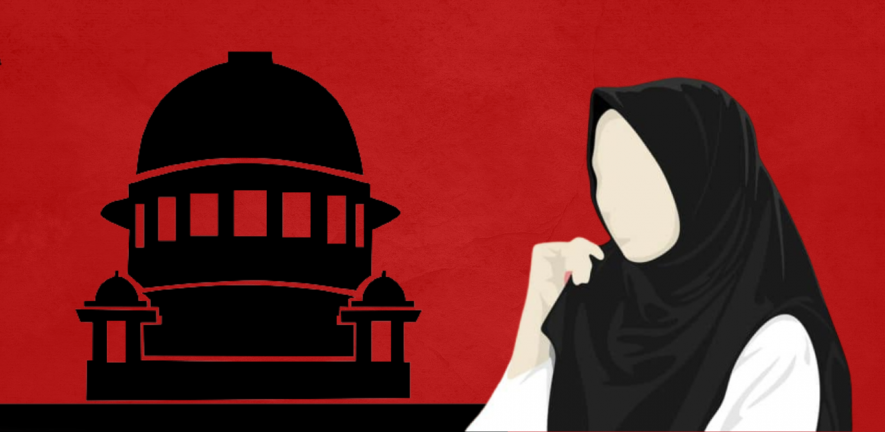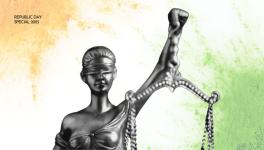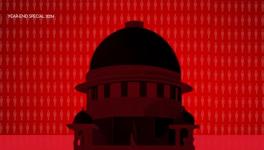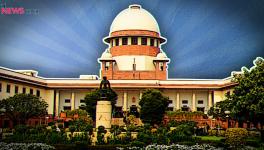SC’s Split Verdict on Hijab: Discipline, Individual Right And Democratic Politics

Despite his right conservative universe of meaning, Justice Gupta ends up espousing a progressive position on the question of hijab. On the other hand, Justice Dhulia’s left-liberal universe of meaning speaks to the most reactionary elements of the so-called religious minority, convinces them about the elegance of their ugliness, and entices them to celebrate their democratic poverty.
——-
The Indian legal fraternity in general and its judicial members in particular derive great pride and pleasure in asserting their ‘objective neutrality’. However, legal theory, both in the tradition of realist school and critical legal realism, has acknowledged the role of ideology and personal disposition of judges in deciding specific cases.
It is well established how judges first take a decision in hard cases and then develop their reasoning with the help of legal provisions, precedents and rules of interpretation to justify their decision. Post-structural discourse theory persuasively demonstrates that such a process need not be animated by active prejudice, hostility or a will to undermine the rule of law. Rather, the universe of meaning in which a judge is embedded makes them think, feel and live in the fairness or justness of their decision. Such a universe of meaning inter alia comprises the totality of linguistic, social, cultural, political, and legal practices to which an individual is exposed.
The split verdict on the hijab issue by the Supreme Court in Aishat Shifa versus The State of Karnataka earlier this month is a good occasion for the members of the legal fraternity to unveil themselves from the hollow of objective neutrality.
Analysis of Justice Gupta’s opinion
Justice Hemant Gupta’s opinion is constrained primarily on the grounds of ‘discipline’ and how children should be raised in a school environment sans any religious undertones to cultivate scientific and secular outlook. For this purpose, he thinks students must wear the uniform dress without any addition or subtraction.
It is amazing to believe that just because students are forced to look alike, they will develop a sense of unity and purpose. What is the evidence for such an assumption? If dressing alike can create such a magical effect, what would be the next step: impose a dress code on the entire population?
However, does this concern only wearing the headscarf or any other symbol of religion? What about kada, kaleva and a variety of religious pendants? Bindi, topi and mangalsutra are common religious symbols among teaching and non-teaching school staff. How to reconcile with a situation where school students cannot wear anything that indicates religious identity, but when they enter a certain kind of school they could be exposed to full-fledged ideology of religion through religious instruction or inbuilt places of worship therein? Think of the presence of churches and Christian symbolism in schools run by the Catholic Missionaries in India. Think of the presence of Islamic symbolism in madarsas and other minority educational institutions. Just visualise numerous mandir-branding schools, both literally and figuratively, full with Hindu symbolism. Are we going to ban all of it?
Justice Gupta, in his opinion, wrote that in a “pre-university college, the students should look alike, feel alike, think alike and study together in a cohesive cordial atmosphere.” It is amazing to believe that just because students are forced to look alike, they will develop a sense of unity and purpose. What is the evidence for such an assumption? If dressing alike can create such a magical effect, what would be the next step: impose a dress code on the entire population?
However, the argument that the students should also ‘feel alike’ as well as ‘think alike’ is far more problematic. Schools and colleges are expected to develop our cognitive senses, and our ability to feel, perceive and think differently and also independently which makes such cognitive skills sharper and healthier. Therefore, wearing or not wearing the hijab does not quite relate to this logic. Justice Gupta quoted Tajamul Husain from the Constituent Assembly where he had pressed against the flashing of religious symbols in public, to support his conclusion. However, the Constituent Assembly had squarely rejected the views of Husain, which now finds favour with Justice Gupta in his judgment.
Justice Gupta badly wrestled with the essential religious practices (‘ERP’) test and how it will operate vis-a-vis the hijab. After a long tour of Quran, Hadis and their multiple interpretations, Justice Gupta came to the conclusion that whether hijab is an ERP is beside the point. Nor can the decision about the hijab be taken in comparison with the Sikh kirpan or pagdi as “the essential religious practices of the followers of Sikh faith cannot be made basis of wearing of hijab/headscarf by the believers of Islamic faith.” In this way, Justice Gupta manages to partially apply the ERP test while simultaneously refusing to pronounce on the essentiality or non-essentiality of hijab under Islamic theology!
Austrian-British philosopher Ludwig Wittgenstien explained such language games by asserting that there is no instance of application of a rule which does not create a rule itself. In the same vein, Justice Gupta brushes aside the effect of uniform on Article 19(1)(a) of the Constitution as ‘incidental’, which in his opinion is not an unreasonable restriction. But he reserved the greatest linguistic violence for the concept of social justice, which he translated to mean students behaving in a fraternal manner transcending their group identity.
Justice Gupta equates fraternity with homogeneity, forgetting that the former term has been used in the Constitution precisely to contain the latter impulse.
Social justice under the Constitution implies substantive access to common goods like education, services and power positions for the marginalised social classes. But Justice Gupta innocently believes that the uniform is an equaliser of inequalities. Similar violence to the concept of fraternity is visible in his observation that fraternity will stand fragmented as the apparent distinction of some of the students wearing headscarf would not form a homogeneous group. Here, Justice Gupta equates fraternity with homogeneity, forgetting that the former term has been used in the Constitution precisely to contain the latter impulse.
One ambitious observation of Justice Gupta is not taken to the natural conclusion by him. He observed in Para 160 that before a student goes for higher studies in colleges, she should not grow with a specific identity, but under the umbrella of equality guaranteed under Article 14 of the Constitution transcending the group identity. Such a finding would warrant a decree against the present hierarchical education system in favour of a common education system.
However, his conception of equality begins and ends with religious toiletries. While uniformity of uniform is such a prized value for Justice Gupta, he does make reasonable accommodation for the ‘diversity of rules’ as applicable to the Kendriya Vidyalayas across the country which permit the wearing of headscarf/hijab, and to some states which proscribe it.
Justice Gupta used the language and symbols of secularism, minority rights, religious freedom, equality, discipline and national cohesion to vindicate his position on the issue. His judgment in many ways falls squarely within the ideological universe of the right conservative faction, laced in the constitutional vocabulary. Interestingly, despite his right conservative universe of meaning, Justice Gupta ends up espousing a progressive position on the question of hijab.
Analysis of Justice Dhulia’s opinion
The second opinion by Justice Himanshu Dhulia charts a completely different path. First of all, he rescued the issue from the ERP test by framing it as an individual concern rather than a group activity. Accordingly, he decided to evaluate the ban on hijab on the touchstone of fundamental rights of an individual under Articles 19(1)(a), 21 and 25(1) of the Constitution.
The retention of communally-constructed majority and minority categories through constitutional mediation is precisely what endangers the fundamental rights of those bracketed under the minority category.
Justice Dhulia’s opinion adds fuel to the growing de-legitimacy of the ERP test, which is under review before a nine judges Constitution bench of the Supreme Court. He then chose to decide the issue at hand with reference to the Supreme Court’s Bijoe Emmanuel judgment, in which Articles 19(1)(a) and 25(1) came to the rescue of kids belonging to Jehovah’s Witnesses sect who refused to sing the national anthem but stood respectfully while it was sung by others. Justice Dhulia here implies that the girls who in present case respectfully wear a matching hijab along with full uniform, comply with the substance of State mandate on uniform and remain within the protective umbrella of Articles 19(1)(a) and 25(1).
He then took on the Karnataka High Court comparison of a school with a war room or defence camp, and found no justification for imposing a military-like discipline inside a classroom which is a public place. He refused to privilege discipline over freedom and dignity protected by the Constitution. He held that the ban on hijab militates against the rights to dignity and privacy, which are protected under Articles 19(1)(a), 21 and 25(1) of the Constitution, and are in no way derivative rights.
Justice Dhulia, by referring to a Constitutional Court judgment of South Africa in the ‘nose-stud’ case, and a decision of the House of Lords in England in the ‘jilbab case’, came to the conclusion that making reasonable accommodation in favour of girl child to facilitate her education does not break the discipline of a school in any serious way. He had no hesitation in privileging the education of a girl child over the enforcement of a Dress Code.
Justice Dhulia refers to the prayer of the petitioners with a pleading tone, “All the Petitioners want is to wear a hijab! Is it too much to ask in a democracy? How is it against public order, morality or health? or even decency or against any other provision of Part III of the Constitution.” He then batted for reasonable accommodation in this case as a sign of a mature society which has learnt to live and adjust with its differences.
The following words of Justice Dhulia in defence of individual liberty will ring for a long time: “A girl child has the right to wear hijab in her house or outside her house, and that right does not stop at her school gate. The child carries her dignity and her privacy even when she is inside the school gates, in her classroom.” However, for the protection of these rights, he places his hopes on the Constitution as a document of trust which minorities have reposed upon the majority. Herein lies the folly of his approach. The retention of communally-constructed majority and minority categories through constitutional mediation is precisely what endangers the fundamental rights of those bracketed under the minority category.
A permanent minority which refuses to play the democratic power game is rendered defenceless and clueless by the instrument of ‘trust’. As a result, it develops a childlike fascination for frivolous issues like triple talaq, hijab or polygamy – all against its own womenfolk. This brings out the hollowness of Justice Dhulia’s left-liberal universe of meaning. It speaks to the most reactionary elements of the so-called religious minority, convinces them about the elegance of their ugliness, and entices them to celebrate their democratic poverty. No wonder, it remains blind to the Islamophilic foundations of the hijab fetish, and fails to acknowledge its constitutive role in mobilising right-wing sentiments cutting across religious lines.
Decades of neoliberal hegemony has increased precariousness and atomisation among the people, generating unprecedented alienation in our caste society. As economic policies are beyond popular public scrutiny, it is the social that must bear the brunt of people’s passions and emotions. Under these conditions, to mistake an exclusive community demand as an individual right, reinforces the longing for communal experience in the atomised self of those who perceive themselves endangered.
To be sure, communal mobilisation and strategic counter-mobilisation is a regular feature of electoral democracy, witnessed prominently during the Shah Bano, Mandal and Kamandal moments. Neoliberal disenchantment has made them more ferocious. The left-liberal failure to grasp the nature of democratic process has thrown the masses to a dangerous pit. Even the reference to Dr. B.R. Ambedkar’s timeless words on fraternity by Justice Dhulia cannot rescue it.
Dr. Ayaz Ahmad is an Associate Professor of Law at Karnavati University, Gandhinagar, Gujarat.
Dr. Nachiketa Mittal is a professor of law and an independent researcher.
Get the latest reports & analysis with people's perspective on Protests, movements & deep analytical videos, discussions of the current affairs in your Telegram app. Subscribe to NewsClick's Telegram channel & get Real-Time updates on stories, as they get published on our website.
























